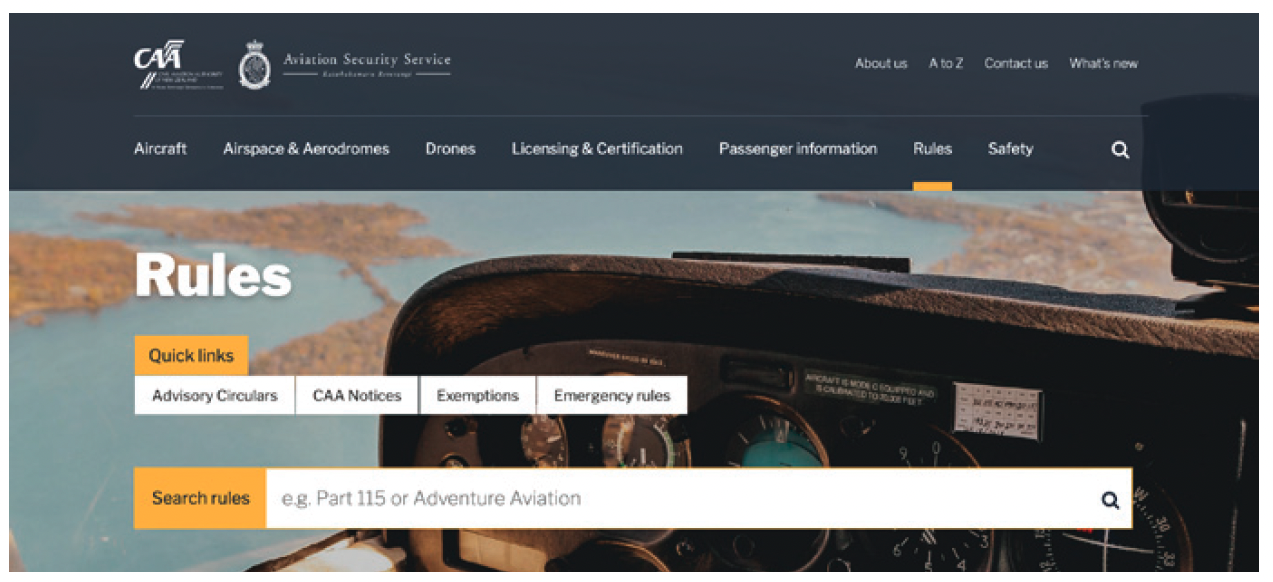By Ivor Yockney
We all need to be familiar with, and abide by, the Civil Aviation Rules (CARs). This article is a response to common rule-based questions asked by pilots, and a few recent prosecutions.
For most, the CARs become familiar during pilot training and are revisited for a refresher before a BFR. Unless you’re dealing with the rules all the time, it’s all too easy to get complacent and forget, misunderstand or, worse still, disregard the rules as ‘just a guideline’.
While some of the CARs can seem outdated and not agile enough to move with the times, others are predicated on safe flying practices. It is these I’d like to focus on here. For those who have attended the excellent CAA Safety Course, you’ll be familiar with the term ‘Blood Priority’ Rules. This refers to the CARs that are based on accidents that have resulted in fatalities.

It is commonly said that there are no new causes of accidents; all accidents are iterations or variations of previously proven accident causes. Very few accidents are caused by a single factor. It is far more common that they result from a chain of events. This is sometimes referred to as the ‘Swiss cheese model’, where the accident occurs when all the holes line up, and, conversely, if any one of those holes had been blocked, the accident would not have eventuated.
Now, I’m not suggesting that by diligently sticking to the rules you can ensure that nothing will ever go wrong, but if you look back through CAA fatal accident reports, you can often find deviations from the rules which, if the rules had been followed appropriately, could have prevented the accident from occurring. Two of the rules for VFR GA pilots in New Zealand that seem to keep reoccurring in accident reports are Meteorological Minima, and Minimum Heights for VFR flight. Others that crop up include fuelling of aircraft, BFR requirements, minimum fuel requirements, carriage of dangerous goods, requirements for and contents of a passenger briefing.
So, do we all know them? Do we all stick to them? Knowing the rules is straightforward. Next time you have a few minutes, open your flight tablet and skim through the rules.
Apps such as OzRunways have all the documentation available at the touch of a button. Alternatively, you can find them on the CAA website. It’s easy for those who fly regularly with aero clubs or work for an aviation organisation to be immersed in and familiar with the rules – but it is equally easy for those of us not regularly exposed to a club or professional environment to go a couple of years without reference to the rules, and even to forget how to find them! Once you know them, stick to them!
Knowingly deviating from the rules is different to inadvertently breaking them through inattention or forgetfulness. The human factors behind such a scenario can be complex: lack of discipline, ignorance, time pressure, the decision to take a one-off small risk for a big gain (get-home-itis comes to mind). These behaviours are linked to the attitudes we all studied in Human Factors (anti-authoritarian, impulsive, sense of invulnerability, machismo). The rules are a legal bare minimum (thinking about weather), and there is merit to having a personal minimum that is set higher than the CARs – similar to the recommendation in the open road speed limit ‘It’s not a target’ campaign.
I was taught by a flying mentor that when planning a flight operation, you should start at the ‘accident scene’ and work backwards. By this, I mean writing up your own accident report in your mind prior to taking the flight. What is that accident report likely to say? That the root cause of the accident was the PIC deviating or disregarding the rules?
The Civil Aviation Rules around flight are there to protect us. They are often based on fatal outcomes that we can all learn from and thus avoid repeating. Observing them is a legal obligation, with prosecutions or insurance declines a very real possibility, especially with the ability to retrospectively interrogate technology in EFB apps and ADS-B.
Access to the rules is easy. Become familiar with them, stick within them, and avoid becoming another prosecution case or, worse still, an avoidable accident statistic.
This article first appeared in the Winter 2021 edition of Approach Magazine, the dedicated magazine of AOPA NZ, which is published quarterly.

